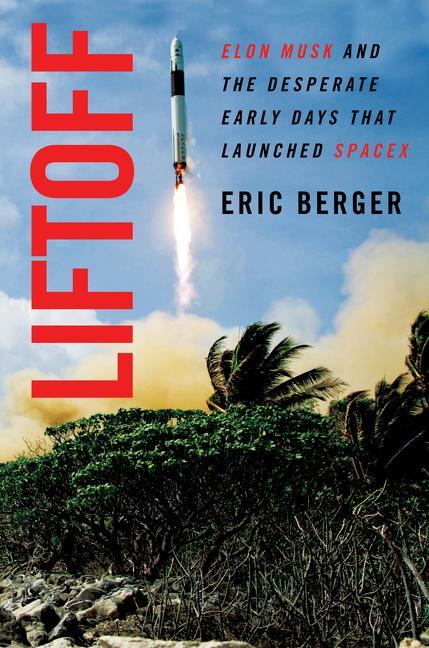
4 minute read
by Eric BergerLiftoff
FORTHCOMING TITLES
LIFTOFF Elon Musk and the Desperate Early Days that Launched SpaceX ERIC BERGER
Advertisement
The little-known story of SpaceX’s first four rocket launches, and the engineers, mathematicians and visionaries that gave everything they had to usher in a new age of space exploration.
From 2006 to 2008, on a remote atoll in the Pacific, the private US rocketry company SpaceX struggled to get its homemade single-engine rocket, the Falcon 1, into orbit. The first rocket exploded about 30 seconds into its flight. The second reached space… for all of eight minutes, when its engine sputtered out. The third was looking more promising until its just-separated first stage actually caught up with the second stage, triggering an explosive collision at the edge of space. With one rocket remaining, SpaceX’s young team knew its fate was tied to the fourth attempt. ‘If we had not reached orbit on that attempt, SpaceX would not exist’, the company’s founder Elon Musk himself acknowledged in a statement in 2018. (Spoiler alert: the fourth rocket operated like a dream, of course, and SpaceX has spent the past 10 years building a leading position in humanity’s space exploration efforts.)
Yet owing to the reclusive nature of SpaceX, the full story of these early years, far from the gleaming headquarters and high-profile successes of today, is largely unknown. In LIFTOFF, Eric Berger draws on his unprecedented access to SpaceX to reveal the full narrative of this foundational generation, profiling the pioneering team that grew SpaceX from nothing, survived three straight failures and lifted SpaceX from mockery to ascendancy in space exploration. LIFTOFF is the story, not of Elon Musk, but of the people who gave up safe jobs elsewhere to build the future of space exploration.
ERIC BERGER has been a reporter and editor in Houston for more than two decades. With a background in astronomy and a master’s degree in journalism, he has written mostly about science and, more recently, spaceflight. After a long career at the Houston Chronicle, he joined Ars Technica in 2015 as the website’s senior space editor, covering SpaceX, NASA and everything beyond. For his reporting since then, he won the 2015 NewSpace Journalism award from the Space Frontier Foundation and a 2015 Space Pioneer award from the National Space Society. A certified meteorologist, he also maintains a widely read weather forecasting website for the greater Houston area, Space City Weather. He was a Pulitzer prize finalist for his coverage of Hurricane Ike at the Houston Chronicle in 2008.
Agent: Jeff Shreve
Publisher: Wiliam Morrow (Harper Collins US) Publication: Spring 2021 Status: Draft manuscript Length: 75,000–85,000 words words
All rights available excluding World English Language (Morrow), China (Guomai Culture and Media), Korea (Third Moon Publishing), Russia (Eksmo)
FORTHCOMING TITLES
REIMAGINING TIME A Light-speed Trip Into Einstein’s Mindbending, World-changing Theory of Relativity TANYA BUB & JEFFREY BUB
Praise for TOTALLY RANDOM

Accessible, smart, and funny. An entanglement page-turner! – David Kaiser, author of HOW THE HIPPIES SAVED PHYSICS
A book about relativity that puts the pictures in Einstein’s head into the heads of its readers.
Like many people interested in the theory of relativity, the artist, philosopher and humorist Tanya Bub had never read Einstein's original work, somehow assuming she would be better off with more modern takes on the subject. But after idly clicking on a link to the 1905 paper Einstein had written when he was 24 years old – a first stab at explaining to the world his revolutionary ideas on space, time and matter – she ended up spending two years absorbed in his imaginative vision of the world.
What particularly struck her was that Einstein used words and maths to draw pictures in his readers’ minds. As she worked through his paper, she sketched in little diagrams and doodles to help her keep track of the thread of his argument and understand the rationale behind his equations. Soon her imagined scenarios became more elaborate, with props ranging from trains, mirrors and light guns to balloons, ice-cream cones and baseballs. Much to her surprise it turned out that the pictures could also generate numbers – the same values usually calculated with abstract mathematical equations. But here the pictures made intuitive sense because they came with a story.
In REIMAGINING TIME, Tanya Bub teams up with her father, the distinguished physicist Jeffrey Bub, to explain relativity in a way that’s never been done before. It’s a deliciously visual, wildly creative journey that reveals astonishing truths about the world we inhabit: time is relative, lengths get shorter with motion, the Universe has a speed limit, energy and mass are interchangeable, and gravity is the same thing as acceleration. The result: a quirky, funny accessible blend of science and art that goes to the heart of one of science’s most revolutionary discoveries.
TANYA BUB is the founder of 48th Ave Productions, a web-development company. She has degrees in philosophy of science from McGill University and fine arts from the Emily Carr University of Art and Design in Vancouver.
JEFFREY BUB is a Distinguished University Professor at the University of Maryland. He studied physics with David Bohm at Birkbeck College, London, and philosophy of science with Karl Popper and Imre Lakatos at the London School of Economics.
Tanya and Jeff’s first book together, TOTALLY RANDOM: Why Nobody Understands Quantum Mechanics (Princeton University Press, 2018), was voted best quantum physics book of 2018 by Ethan Siegel of Forbes magazine (‘If you ever wondered about quantum entanglement and why it's so weird, this book is perhaps the best, simplest explainer of how it actually works’).
Agent: Peter Tallack
Publisher: Yale University Press Publication: 8 June 2021 Status: Proofs Length: 192 pages









